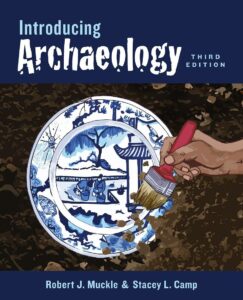Now in its third edition, Introducing Archaeology continues to be a thoughtful and engaging textbook for introductory-level students. In this post, co-author Stacey L. Camp talks us through some of the updates to the third edition and shares an excerpt from chapter five of the book on inclusivity within archaeology.
***
By Stacey L. Camp
 Hi! This is Dr. Stacey Lynn Camp, and I am the second author on the third edition of Introducing Archaeology. I was excited when Bob Muckle, the first author, asked me to contribute and write portions of the third edition because I had already been using the textbook in my Introduction to Archaeology class at Michigan State University.
Hi! This is Dr. Stacey Lynn Camp, and I am the second author on the third edition of Introducing Archaeology. I was excited when Bob Muckle, the first author, asked me to contribute and write portions of the third edition because I had already been using the textbook in my Introduction to Archaeology class at Michigan State University.
There are two reasons I adopted the textbook initially. First, I really like that the textbook covers all the basic concepts in archaeology without going into too much detail that might overwhelm a student new to archaeology. Second, the textbook is student-centered, and what I mean by that is that Bob really understands that most of our students in intro courses are there for general education requirements, so this is our one big chance to demonstrate archaeology’s relevance in our world. He explores topics that are of importance to our communities and our students, such as the archaeology of homelessness, undocumented migration, and social activism and political dissent.
So why buy the third edition if the second was so good?
Well for me the third edition really rounds out the book by 1) looking at both contemporary issues facing the discipline of archaeology and 2) expanding case studies that show students how archaeology contributes to issues they care about. In the third edition, we discuss gender equity in the discipline, the politics of the Dakota Access Pipeline and archaeology’s role in it, Indigenous archaeology and movements to decolonize archaeology, the archaeology of climate change, and contemporary attempts at making the discipline more accessible and inclusive to people of all walks of life. We have also tried to make this book more engaging to our students by providing illustrations and visualizations of archaeological concepts and practices, such as workflow in the lab; the many theoretical lenses of archaeology; lithic technology; and site formation processes. This new artwork, which is unique to our textbook, has been drawn by Dr. Katherine Cook, an archaeology professor and artist who understands the power of images to clearly convey complex ideas and concepts.
***
Excerpt from chapter five of Introducing Archaeology, Third Edition
From Exclusivity to Inclusivity: Making Archaeology an Equitable Profession
As a discipline that has historically excluded minorities and women, archaeology has been slow to adopt practices that seek to include people of all walks of life. Archaeology has traditionally been defined as field-based science, which poses unique physical, geographical, and logistical obstacles for archaeologists.
Archaeologists are faced with financially and emotionally difficult decisions that include covering the costs of childcare; making the decision to leave their children at home, or bring them to the field if it is permitted on site or if it is safe to do so (Goldstein et al. 2018); dealing with universities or employers who prohibit archaeologists and other field crew members from bringing children to archaeological sites; stereotypes regarding who can be considered an archaeologist (Heath-Stout 2019); and being away from those in their care for long periods of time (Camp 2019). Elder care also presents similar challenges for archaeologists who conduct fieldwork. But child and elder carework are statistically more likely to fall on the shoulders of women around the globe (Covan 1997). In addition, some archaeologists, known as “multigenerational caregivers,” find that they are responsible for the care of both children and elders at the same time (Livingston 2018). This is due to two modern factors: (1) women delaying having children until they are done with their education and/or gainfully employed, and (2) people living much longer than previous generations.
Archaeologists have also been slow to recognize that archaeology must accommodate people who have disabilities, despite antidiscrimination laws that prevent people with disabilities from being excluded in the workplace and denied access to higher education (Fraser 2007; Phillips and Gilchrist 2012; Enabled Archaeology Foundation n.d.). There is a growing understanding in the discipline that it must become more inclusive, not only to improve and nuance our interpretations of people in the past, but also to ensure our discipline does not actively exclude and create barriers for people with disabilities. The Inclusive Curriculum Project in Britain, for instance, has sought to make archaeological field experiences more inclusive and accessible for students by creating a toolkit called the Archaeological Skills Self-Evaluation Tool Kit (ASSET) and a handbook for educating archaeology students with disabilities (Phillips et al. 2007). This allows students to identify the abilities that they bring to the field. The toolkit is not only for students who have disabilities, but rather enables all students to assess their strengths and how they could be of benefit to an archaeological project.
Though archaeology has long remained the domain of men with power and privilege, studies acknowledging archaeology’s history of exclusion and discrimination against people who don’t fit the white male mold are small steps forward for the discipline. Addressing inequality within the field will hopefully open archaeologists’ eyes to the problems in their discipline and fuel them to work toward change.
***
Click here to read a full excerpt from Introducing Archaeology, Third Edition.
Need an Exam Copy?
To request exam or desk copies of Introducing Archaeology or any other UTP title, please email requests@utorontopress.com and be sure to include the course name and number, start date, and estimated enrollment.

